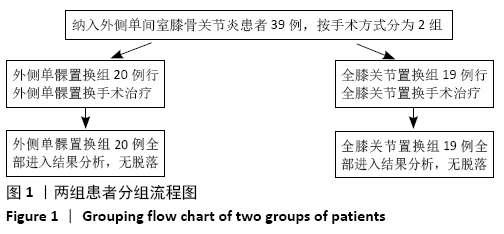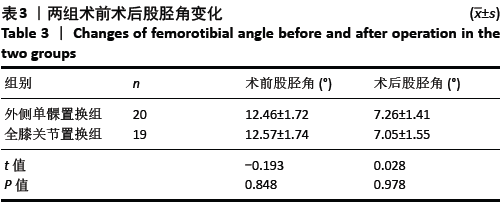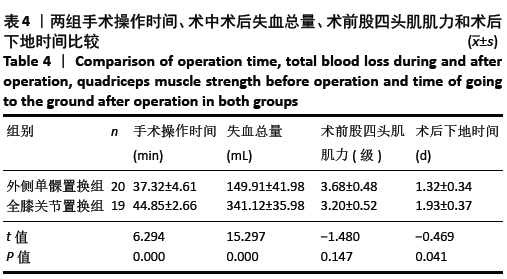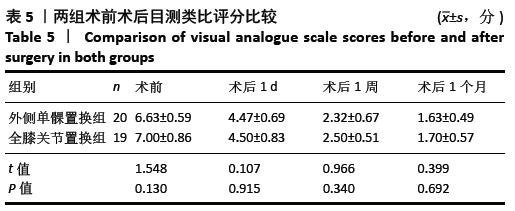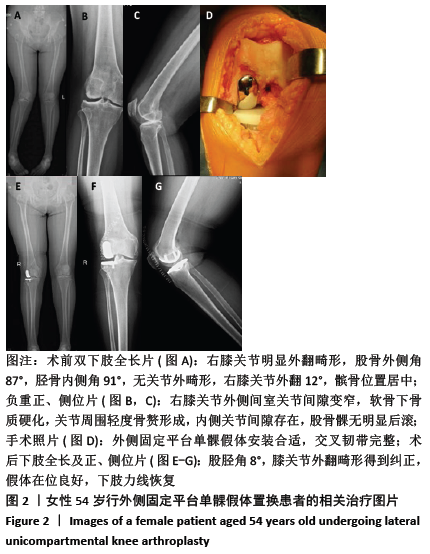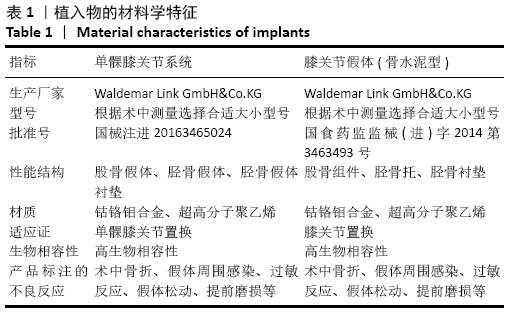[1] MCKEEVER DC. The classic: tibial plateau prosthesis. McKeever, 1960. Clin Orthop Relat Res. 2005;44(44):4-8.
[2] 郑冲,卢伟杰.单髁膝关节置换术应用进展[J].中华关节外科杂志(电子版),2019,13(6):740-744.
[3] 聂宇,张峰,樊宗庆,等.膝关节单髁置换术的临床治疗进展[J].南通大学学报(医学版),2019,39(2):121-124.
[4] 杨曦,许红林,李天鹏,等.膝关节单髁置换术的临床应用初步结果分析[J].中国矫形外科杂志,2013,21(5):511-513.
[5] SCOTT RD. Lateral unicompartmental replacement: a road less travelled. Orthopedics. 2005;(28):983-984.
[6] OHDERA T, TOKUNAGA J, KOBAYASHI A. Unicompartmental knee arthroplasty for lateral gonarthrosis: midterm results. J Arthroplasty. 2001;16(2):196-200.
[7] BAUMANN F, BAHADIN Ö, KRUTSCH W, et al. Proprioception after bicruciate-retaining total knee arthroplasty is comparable to unicompartmental knee arthroplasty. Knee Surg Sports Traumatol Arthrosc. 2017;25(6):1697-1704.
[8] DEMANGE MK, VON KEUDELL A, PROBST C, et al. Patient-specific implants for lateral unicompartmental knee arthroplasty. Int Orthop. 2015;39(8):1519-1526.
[9] XUE H, MA T, WEN T, et al. Lateral unicompartmental knee arthroplasty through a lateral parapatellar approach for lateral compartmengtal osteoarthritis. Zhongguo Xiu Fu Chong Jian Wai Ke Za Zhi. 2015;29(1): 19-23.
[10] LUSTIG S, ELGUINDY A, SERVIEN E, et al. 5-to 16-year follow-up of 54 consecutive lateral unicondylar knee arthroplasties with a fixed-all polyethylene bearing. J Arthroplasty. 2011;26(8):1318-1325.
[11] 陶可,王白成,林剑浩,等.髌旁外侧入路膝关节置换术矫正外翻膝畸形的研究进展[J].中华骨与关节外科杂志,2019,12(5):384-388.
[12] LIM CS, KIM JM. Significant proportion of severe lateral osteoarthritis in korean patients have non-valgus knee alignment with milder clinical manifestation. Orthop Traumatol Surg Res. 2020;106(3):487-493.
[13] 张博,林源,任世祥,等.外侧单髁置换术治疗膝外侧间室骨关节炎的早期效果[J].中华外科杂志,2020,58(2):125-130.
[14] GUNTHER T, MURRAY D, MILLER R. Lateral unicompartmental knee arthroplasty with Oxford meniscal knee. Knee. 1996;(3):33-39.
[15] BROBERG JS, NDOJA S, MACDONALD SJ, et al. Comparison of contact kinematics in posterior-stabilized and cruciate-retaining total knee arthroplasty at long-term follow-up. J Arthroplasty. 2020;35(1): 272-277.
[16] KIM E, TALMO CT, ANDERSON MC, et al. Incidence and risk factors for posterior cruciate ligament avulsion during cruciate retaining total knee arthroplasty. J Knee Surg. 2019;32(11):1138-1142.
[17] KANG KT, KWON SK, KWON OR, et al. Comparison of the biomechanical effect of posterior condylar offset and kinematics between posterior cruciate-retaining and posterior-stabilized total knee arthroplasty. Knee. 2019;26(1):250-257.
[18] STUKENBORG-COLSMAN C, OSTERMEIER S, HURSCHLER C, et al. Tibiofemoral contact stress after total knee arthroplasty: comparison of fixed and mobile-bearing inlay designs. Acta Orthop Scand. 2002; 73(6):638- 646.
[19] 洪海平,卫晓恩,陈勇,等.膝骨关节炎患者股四头肌肌张力与膝关节功能的关系研究[J]. 中医正骨,2014,26(10):32-34.
[20] 张振东,陈俊峰,沙蕉,等.单髁置换术后早期功能康复的回顾性分析[J]. 生物骨科材料与临床研究,2018,15(5):76-77+80.
[21] 郭剑鸿,谢楚海,陈斌伟.膝关节骨关节炎患者股四头肌肌力相关指标变化及其与疼痛程度的关系[J].中国骨科临床与基础研究杂志,2014,6(6):339-344.
[22] 薛华明,马童,文涛,等.髌旁外侧入路外侧单髁置换术治疗膝关节外侧间室骨关节炎[J].中国修复重建外科杂志,2015,29(1):19-23.
[23] BEREND KR, KOLCZUN MC 2ND, GEORGE JW JR, et al. Lateral unicompartmental knee arthroplasty through a lateral parapatellar approach has high early survivorship. Clin Orthop Relat Res. 2012; 470(1):77-83.
[24] 张涛,黄华扬,王庆,等.外侧髌旁入路膝关节置换术治疗膝外翻合并膝骨关节炎的疗效分析[J]. 中华关节外科杂志(电子版),2016, 10(3):249-254.
[25] 程文丹,李子煜,吴一博,等.髌旁外侧髂胫束止点剥离入路TKA治疗膝外翻[J].中国矫形外科杂志,2019,27(11):991-995.
[26] BURGER JA, DOOLEY MS, KLEEBLAD LJ, et al. What is the impact of patellofemoral joint degeneration and malalignment on patient-reported outcomes after lateral unicompartmental knee arthroplasty? Bone Joint J. 2020;102-B(6):727-735.
[27] WADA K, PRICE A, GROMOV K, et al. Clinical outcome of bi-unicompartmental knee arthroplasty for both medial and lateral femorotibial arthritis: a systematic review-is there proof of concept? Arch Orthop Trauma Surg. 2020;140(10):1503-1513.
[28] 袁艾东,钟志年,何正言,等.髌旁外侧入路在中重度外翻膝全膝关节置换术中的应用[J].中国现代手术学杂志,2019,23(4):289-293.
[29] 程文丹,李子煜,吴一博,等.髌旁外侧髂胫束止点剥离入路TKA治疗膝外翻[J].中国矫形外科杂志,2019,27(11):991-995.
[30] 郭建斌,李坤,王亚康,等.人工全膝关节置换术治疗膝关节外翻畸形[J].中华骨与关节外科杂志,2018,11(1):20-24.
[31] 薛华明,蔡珉巍,涂意辉.膝关节外侧间室单髁置换术临床应用进展[J].中华关节外科杂志(电子版),2012,6(3):456-460.
[32] 叶晔,刘又文,李无阴,等.单髁置换治疗股骨外髁重度剥脱性骨软骨炎[J].中国矫形外科杂志,2020,28(9):837-840.
[33] VOLPI P, MARINONI L, BAIT C, et al. Lateral unicompartimental knee arthroplasty: indications,technique and short-medium term results. Knee Surg Sports Traumatol Arthrosc. 2007;15:1028-1034.
[34] GILL JR, NICOLAI P. Clinical results and 12-year survivorship of the Physica ZUK unicompartmental knee replacement. Knee. 2019;26(3): 750-758.
[35] GALLO J, KRIEGOVA E, KUDELKA M, et al. Gender Differences in Contribution of Smoking, Low Physical Activity, and High BMI to Increased Risk of Early Reoperation After TKA. J Arthroplasty. 2020; 35(6):1545-1557.
[36] WAN FY, YUE JA, GUO WS, et al. Glycosaminoglycan Content of the Lateral Compartment Cartilage in Knees Conforming to the Indications for Oxford Medial Unicompartmental Knee Arthroplasty. Chin Med J (Engl). 2018;131(2):194-199.
[37] RANAWAT AS, RANAWAT CS, MARK E, et al. Total knee arthroplasty for severe valgus deformity. J Bone Joint Surg Am. 2005;87(2):271-284.
|
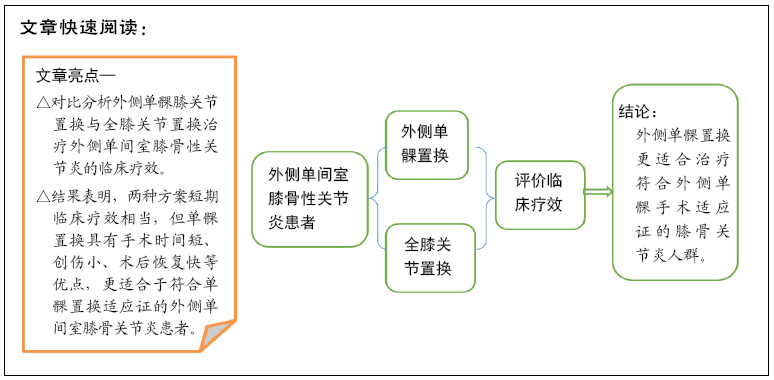 文题释义:
文题释义: